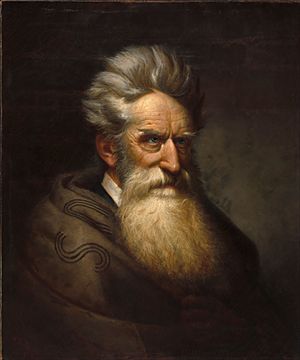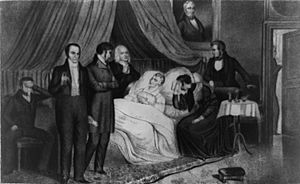George DeBaptiste facts for kids
Quick facts for kids
George DeBaptiste
|
|
|---|---|
| Born | c. 1815 Fredericksburg, Virginia, U.S.
|
| Died | February 22, 1875 (aged 59–60) Detroit, Michigan, U.S.
|
| Occupation | barber, caterer |
| Known for | Underground Railroad |
| Political party | Republican |
George DeBaptiste (born around 1815 – died February 22, 1875) was an important African-American leader. He helped many enslaved people escape to freedom using the Underground Railroad. He worked in southern Indiana and later in Detroit, Michigan.
Born free in Virginia, George moved to Indiana when he was young. In 1840, he worked for US President William Henry Harrison as his valet and White House steward. In the 1830s and 1840s, DeBaptiste was very active in Madison, Indiana. This town was on the Ohio River, right across from Kentucky, where slavery was allowed. Many enslaved people tried to escape through Madison.
DeBaptiste moved to Detroit, Michigan in 1846. Michigan was a free state, but many freedom seekers wanted to go even further to Canada. This was to be safe from US laws that could force them back into slavery. George DeBaptiste became the leader of the local Underground Railroad group in Detroit. He even bought a steamboat to carry people across the Detroit River to Amherstburg, Ontario in Canada. Historians believe DeBaptiste and his friend William Lambert helped hundreds of people find freedom.
Later, in the 1850s, DeBaptiste worked with famous abolitionists like Frederick Douglass and John Brown. During the American Civil War, he helped recruit black soldiers from Michigan to fight for the Union Army. After the war, he continued to fight for equal rights for African Americans. He helped black children get into public schools in Detroit.
Contents
Early Life and Freedom
George DeBaptiste was born around 1815 in Fredericksburg, Virginia. Some records say his parents, John Debaptist and Frances "Franky," were born enslaved but became free before George was born. This meant George was born free. Other stories say his father, George DeBaptiste, legally owned his mother, Maria, and their son, but set them free in 1823.
George learned to be a barber in Richmond, Virginia. When he was a teenager, he married Marie Lucinda Lee, who was enslaved. He used his earnings as a barber to buy her freedom. In 1835, George got a special pass in Virginia that said he was a free "mulatto" (a term used then for people of mixed race). He was described as being about five feet seven and a half inches tall and around 20 years old. He later said he used this pass 33 times to help other enslaved people escape.
Helping Others in Indiana
As a young man, George and his wife moved to Madison, which was a free state. Around 1836, he started businesses. He also began to hide and help enslaved people who were escaping. This was part of his work as a "conductor" on the Underground Railroad. Madison was a key spot because it was on the Ohio River, a common crossing point for people escaping from Kentucky.
DeBaptiste had a network of helpers. This included Dr. Samuel Tibbetts in Madison and William Beard, a Quaker, in Salem, Indiana. Catherine White Coffin and Levi Coffin were also important leaders who helped arrange safe travel for freedom seekers to Canada. In 1840, DeBaptiste, along with Seymour Finney and William Lambert, helped rescue Robert Cromwell. Cromwell was an African-American barber who was being tried in a Detroit courthouse after being recaptured.
Working for President Harrison
Before he became US President, William Henry Harrison lived in Ohio. DeBaptiste became his valet (a personal assistant) during Harrison's election campaign. After Harrison won, he made George the steward of the White House.
President Harrison's time in office was very short; he died after only one month. DeBaptiste became very close to the president and cared for him during his illness. An article written after DeBaptiste died said he was by Harrison's side and held him as he took his last breath. After Harrison's death, DeBaptiste returned to Madison. His barbershop there became a central meeting place for the Underground Railroad in Madison.
Helping Freedom Seekers on the Ohio River
In 1843, DeBaptiste was still living in Madison. He helped Adam and Sarah Crosswhite and their four children escape to freedom. A few years later, in 1847, he helped them again in Detroit as they crossed into Canada. Around this time, DeBaptiste, Lambert, and Coffin also started working with George J. Reynolds.
By 1846, DeBaptiste was still busy along the Ohio River. He helped people escaping from Kentucky cross into Ohio and Indiana, and then on to Michigan and Ontario, Canada. He often loaned his freedom papers to other men who looked like him. This helped them pretend to be free. People who supported slavery wanted to arrest him. They said he didn't pay a $500 bond required for free black people. But Judge Stephen C. Stevens said that law was against the rules. Because he was often attacked in Madison for his anti-slavery work, DeBaptiste had to leave town.
Moving to Detroit, Michigan
In 1846, at age 34, DeBaptiste moved to Detroit. He continued to work as a barber and also sold clothes. His friend William Lambert had also moved to Detroit, and they worked closely together. They were both members of groups like The Order of Men of Oppression, which fought slavery and raised money to help freedom seekers. In Detroit, DeBaptiste was seen as the "president" of the Detroit Underground Railroad. William Lambert was the "vice president" or "secretary," and Laura Haviland was the "superintendent." Henry Bibb was another important person in their group. George's relative, Richard DeBaptiste, also moved to Detroit from Virginia in 1846 and worked with George.
In 1848, DeBaptiste worked as a steward on a steamship called the Arrow. This ship traveled on the Great Lakes between Sandusky, Ohio and Detroit. In 1859, DeBaptiste and William Whipper bought their own lake steamship, the T. Whitney. Since he couldn't get a captain's license (because he was black), he hired a white captain named Atwood. The boat traveled a similar route to the Arrow. It often stopped at Amherstburg, Ontario, Canada, to pick up lumber. It also secretly dropped off freedom seekers.
DeBaptiste did more than just help people escape. He wrote letters to anti-slavery newspapers like the North Star and the Liberator. He was also involved in the larger movement to end slavery across the country. On March 12, 1859, John Brown, Frederick Douglass, William Lambert, and DeBaptiste met at William Webb's house to talk about ending slavery. DeBaptiste suggested blowing up some of the South's biggest churches. John Brown disagreed, saying it would cause too much bloodshed. Before slavery ended, the state of Kentucky offered a $1,000 reward to capture DeBaptiste.

After John Brown's attack and capture, a senator named James Murray Mason led a committee to investigate. He tried to get "George DeBaptiste" to appear before the committee. But the sheriff in Detroit wrote back saying that DeBaptiste was unlikely to obey the summons. So, the summons was never delivered.
After the Civil War
During the American Civil War, DeBaptiste worked with Detroit civil rights activist John D. Richards. They helped recruit Michigan's first black regiment (a group of soldiers). DeBaptiste also worked as a sutler, selling supplies to the soldiers.
After the war, in the late 1860s, DeBaptiste worked with the Freedmen's Bureau. This group helped formerly enslaved people. He also started a catering business in Detroit. He won first prize for his wedding cakes at the 1873 Michigan State Fair.
DeBaptiste continued to fight for civil rights for African Americans. He strongly supported the right of black students to attend Detroit Public Schools. He was a member of the Second Baptist Church in Detroit. In 1870, he was the first black person to be chosen as a delegate for the state Republican nominating convention.
Death
George DeBaptiste died on February 22, 1875. He was survived by his second wife, one son, and one daughter.



